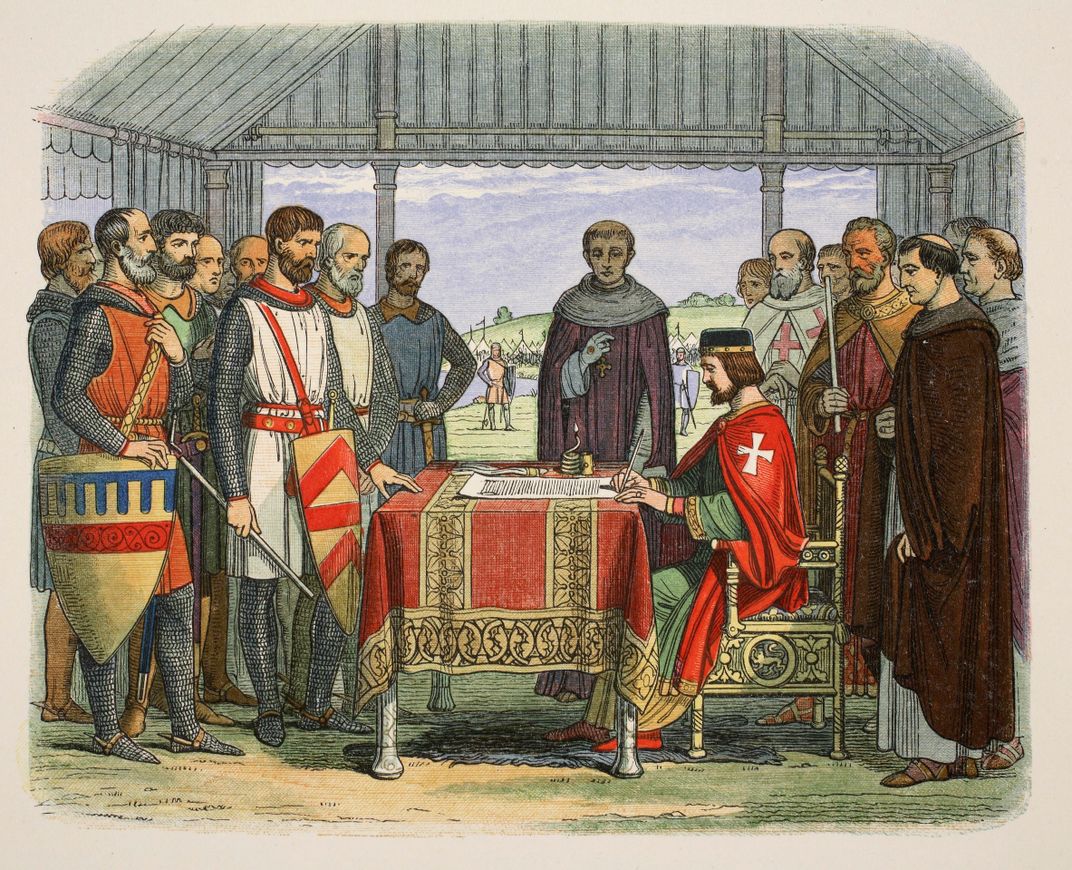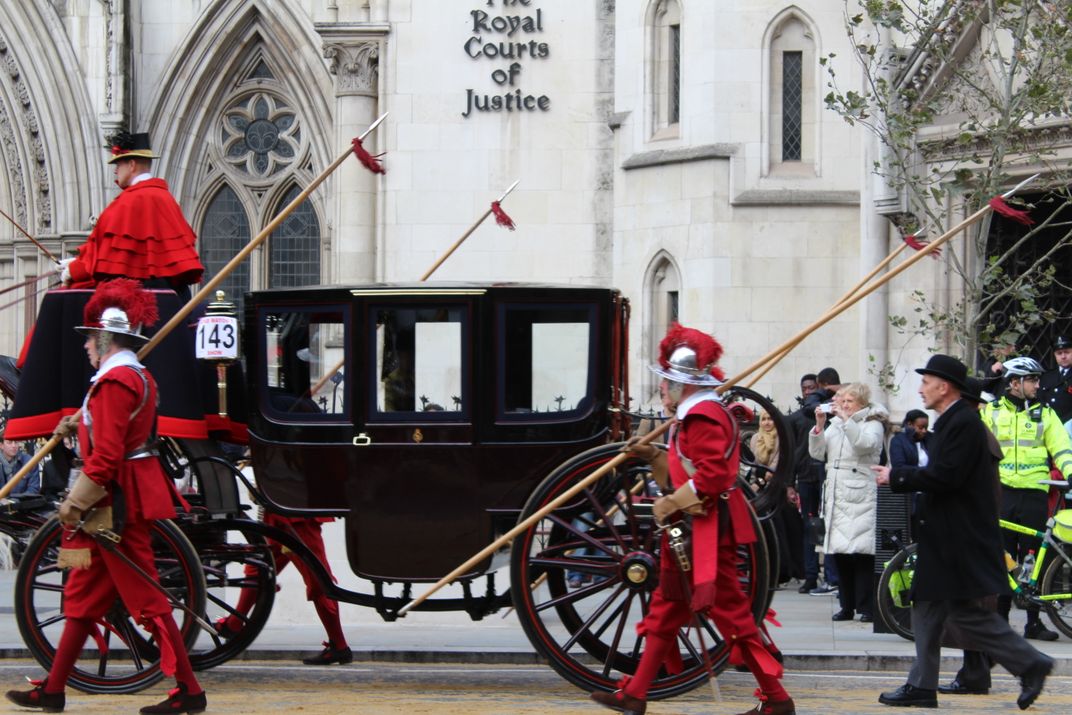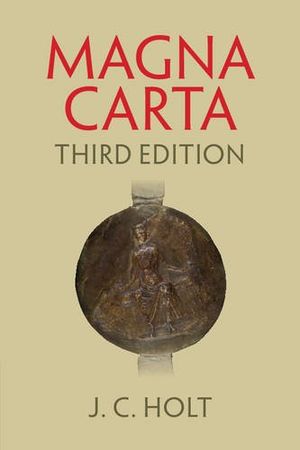How Magna Carta Went Viral
In a world before the printing press, how did news of the famous document make the rounds?
/https://tf-cmsv2-smithsonianmag-media.s3.amazonaws.com/filer/60/59/605942e2-6c49-4470-b7e7-9828eaae7aec/42-69000984.jpg)
In November of last year, a 13th-century copy of Magna Carta went for a drive.
The document—a large, nearly square piece of parchment covered in dense, brownish Latin legalese and bearing a dark green wax seal attached to the bottom with cord—rolled around the City of London in a red and gold horse-drawn coach built for Edward VII. A small camera was fitted to the coach’s ceiling to live-stream the document on its journey. Magna Carta toured London’s financial heart in the company of a Chinese dragon, people in fish costumes riding segways, a Viking ship, a group of Maasai dancers, and Napoleon Bonaparte. It was not, as you might imagine, how a copy of Magna Carta would have traveled in 1215, the year of its first sealing.
The copy’s public appearance was part of the Lord Mayor’s Show, the annual parade celebrating the installation of the Lord Mayor of the City of London in office (incidentally, the first Lord Mayor’s Show also took place in 1215). But the real occasion for the outing was as a reminder that the upcoming year would be an important one: 2015, the 800th anniversary of a document celebrated as the keystone of modern democracy, a symbol of the inalienable rights of humankind and the spiritual ancestor of the United States Constitution and the 1948 Universal Declaration of Human Rights.
To be clear, the copy of Magna Carta that took a drive around the City of London last year dates from 1297, the year it was re-issued and sealed by King Edward I. It is not an “original”; it’s not even based on an original, but instead is a re-issuing of a 1225 version, itself a reissue of a 1217 version, which was again a reissue of a 1216 version. That it is a copy of a copy of a copy speaks to how Magna Carta evolved from the practical resolution of a civil emergency into the totemic enshrinement of liberty that it is today. And it speaks to how Magna Carta went, for lack of a better term, viral.
The story of how Magna Carta was communicated is tied up in how it came to be. King John, one of the great, mustache-twirling villains of British history, and a pack of angry barons, rebels whose main coup was taking control of London, spent June 10 through June 19, 1215 in tense negotiation at the Thames-side meadow of Runnymede. A settlement was reached, and John’s oath to uphold it was given in exchange for the barons’ pledge of allegiance.
This settlement was quickly issued as a royal charter, a proclamation by the king; most of its 63 clauses dealt with grievances about his abuse of feudal custom and detailed actions to curtail it. John, who’d lost a lot of money fighting unsuccessful wars in France, had been using his feudal rights to extort money from his nobles, and when they couldn’t pay, he seized their land and took their family members hostage.
Buried among the stipulations regarding the removal of fish-weirs from the Thames and specifying the rights of wealthy widows were several clauses that would have centuries-long relevance, though no one could have known that at the time. These guaranteed the Church the freedom to handle its business without interference from the throne; that no free man could be imprisoned or outlawed except by the lawful judgment of his equals; and that the right to justice could not be sold, denied or delayed. It wasn’t, as the myth of Magna Carta might imply, the first time that these things were recorded—England had been an established political entity since well before the Norman Conquest in 1066, with laws both customary and written. Rather, Magna Carta represented the first time that they’d been outlined in conjunction with the implicit declaration that the king himself was subject to these laws. Big news—but how, in the absence of a printing press, telegraph, 24-hour news cycle or the Internet, did anyone hear about it?
The answer is murky. What happened at Runnymede is unclear beyond the broad strokes (furious barons in full armor, king in a tight corner), although John’s showdown with his barons probably didn’t include an official Magna Carta document as we might think of it. And it certainly wouldn’t have concluded with him dramatically impressing his seal on anything; this was not a moment for theater, whatever later historians with overheated imaginations might want to believe.

“I think the main thing that the general public will assume that when they go to see Magna Carta is that they think they’re seeing something that was on the isle of Runnymede or that the king signed or sealed and everybody looked, and that is almost certainly not the case,” explained Tessa Webber, a lecturer in palaeography at Cambridge. It is more likely that a draft version of the text hashed out during negotiations, both overt and covert, in the previous weeks and months, was read out to the assembled parties. Once John swore his oath, the 63 clauses would have been pulled together in a charter, not yet called Magna Carta (“Great Charter”), but the “Charter of Liberties”. Who actually wrote the first text is unknown, but some evidence points to the Archbishop of Canterbury, Stephen Langton, one of the architects of the Runnymede negotiations. This text was then copied out in heavily abbreviated Medieval Latin on parchment by trained scribes of the royal chancery, the king’s records and communications office. These “engrossments”, as they’re called, were then affixed with the King’s Great Seal, the physical representation of his authority, and sent out via royal messengers. Simple enough, right?
“When I’m trying to envision what happens in 1215, it’s not like creating one single document. It’s more like sending an email to multiple recipients, and then it gets copied again, or cut and pasted,” said Julian Harrison, co-curator of the British Library’s major exhibition on Magna Carta. Except, this was a message that needed to be copied out by hand by a team of specialists turning around on a tight schedule, that could travel only as fast as a person on a horse could go, and that ultimately might not have even been understood by the very people who needed to enact it. Less simple.
There are four surviving 1215 Magna Cartas, two held by the British Library and one each at Lincoln and Salisbury cathedrals. Each bears the seal date June 15, 1215, although it’s unclear whether they were actually in existence on that day; there was precedent for documents to bear the date they were orally agreed, not the date they were physically sealed. There could have been as many as 41 such copies, one for each shire, or county, and the Cinque Ports, the five ports on the coast of Kent and Sussex. Each of the remaining copies is in a different hand, and each is a different size and shape—one is landscape, two are portrait and one is almost square—written on sheepskin parchment.
Sheepskin was turned into parchment by soaking it in a strong lye solution, making it easier to scrape off the hair and flesh. Then the skin was stretched on a frame to dry under tension, scraped smooth with a crescent-shaped knife called a lunular and trimmed. The individual sheepskin dictates the shape and size of the parchment that results: “You deal with the sheep you’ve got,” says Webber. Given the length of the text—roughly 4,000 words of shorthand Medieval Latin, probably one of the longest documents produced to date—it’s unlikely that a single sheep could have produced more than one Magna Carta.
The ink was made by the same scribe who used it from a combination of water, mineral dust, gum arabic (as a binding agent) and powdered oak-gall, also known as oak-apple. Oak-gall is one of nature’s weirder treasures: When a gall wasp lays its eggs in the bark or on the leaves of an oak tree, the tree forms a smooth ball, like a boil, around the larvae. Inside the ball is tannic acid, which, when in combination with the other ingredients, seems to almost etch into the skin of the parchment. The black ink would have been applied with a quill, a flight feather taken from a goose or a swan. A right-handed scribe held a left wing feather, which curved into the hand; roughly every 10 lines of cramped, spidery scratching, he’d pause to trim the nib with a penknife and dip it into the ink.

Each copy had to be the work of a single scribe, to reduce the opportunity for and appearance of tampering. “You weren’t meant to have any erasures … You weren’t meant to leave any spaces,” Webber explains: Erasures could be construed as signs of forgery, while spaces could leave enough room to squeeze in something unwanted. This is not to say that mistakes weren’t made—the minor variations between the four 1215 Magna Cartas attest to that—but rather that this was precise, hand-cramping, eye-watering work (at least the scribes working on those Magna Cartas would have enjoyed a bit more daylight to work with, being that it was summer).
Once the copies were made, they were each sealed—not signed, which was not a tradition yet and in any case, there is no evidence that John could write—meaning that an impression of the King’s Great Seal was made in a lump of softened beeswax and resin and attached to the bottom of the document by cord. The king himself, however, didn’t do the honors; his Lord Chancellor, the Keeper of the Seal and one of the highest ranking officials in government, would have, or there would have even been yet another person, called a “spigurnel”, to actually apply the seal to the wax. “Royal administration is evolving and getting more complex,” Webber explains. “Titles are quite honorific, and that means you get a package of privileges … but the actual doing of things would have been done by someone less rewarded. This is bureaucracy, basically.” Only one of the four 1215 Magna Cartas still bears King John’s seal, although this copy was badly damaged by a fire in 1731; the wax melted and now resembles an ancient piece of chewed gum.
It’s unknown exactly how long it would have taken to produce a single copy of Magna Carta, but we do know that at least seven copies were ready for dissemination by June 24, 1215—there’s a memo from that date to the effect that two copies were to be delivered to the bishop of Lincoln, one to the bishop of Worcester, and four to the Archbishop of Canterbury’s steward. Another memo indicates that six more copies were sent out on July 22, again to the Archbishop of Canterbury’s steward. The relative haste with which they were produced and sent out gives some clue as to the document’s importance; regular charters could afford to languish a bit.
There was already a fairly robust system of communication between the Crown and the country dating back to at least the 10th century. This was largely in the form of the sealed writ, a kind of dashed-off memo that bore the king’s seal and would be sent off to the shires. Charters, although they were more formal documents, went the same way, carried by royal messengers via “established routes,” says Julia Barrow, director of the University of Leeds’ Institute for Medieval Studies. Any charter, and Magna Carta was no exception, could only travel as fast as the messenger carrying it. At maximum, that’s about 20 to 25 miles a day on horseback—roughly the distance from Runnymede to, say, the Tower of London (then in the hands of the rebel barons). If, as evidence suggests, a messenger changed mounts at staging posts, he could cover as much as 60 to 80 miles a day, and the copies could have traveled to the corners of the kingdom within a week, Barrow says.
Some did, but not all copies would have traveled via royal messenger moving posthaste. In the case of Lincoln Cathedral’s copy, for example, it went with Bishop Hugh of Wells, who had been at Runnymede and who reached Lincoln, a distance of some 140 miles, by June 30, 1215. Harrison is inclined to think that it took rather longer to spread the physical copies around the country: “It’s not instantaneous, it would have been over a period of weeks and months.” More importantly, perhaps, word about what had happened—"which essentially was that John lost,” Barrow says—would have traveled person-to-person probably faster than the physical documents.
However long it took, it seems likely that copies would have been put in the hands of the earls of the shires and bishops in county cathedrals; this is how other writs and royal charters were disseminated, and there’s no reason to believe Magna Carta was an exception. To publicize it, Magna Carta was probably read out at the cathedral and/or a shire court meeting held at a local great hall. (The shire courts, in existence since the Anglo-Saxon kings and made up of the local earl, bishop, and sheriff, were the primary locus of civic justice.) It’s difficult to picture what such a meeting would have looked like, when it would be held, who would be there and how many people from feudal England’s various strata would have attended. But we do know that the charter was probably read out in the vernacular French, Anglo-Norman, that was spoken by the social and political elite of the country—a surprising number of written translations into French from near the time of the sealing survive, including one that appears to have been intended to be read out at the county court of Hampshire.
“It probably would have taken a bit of time, it’s a long document,” says Barrow. Most towns in England boasted a fee-paying school by this time, a marked improvement on the days when the only schools were in monasteries; however, only a small percentage of the population could spare the money or the child labor, so readers remained a relatively small group and mostly male. Among the more likely to be able to read, however, were members of the aristocratic, religious and clerk classes.
Whether those hearing it would have understood what it was enacting in any language, however, is another question—though the document would have been fairly well known, it was probably haphazardly applied. Historian J.C. Holt, in his seminal 1992 analysis of Magna Carta, noted, “On the whole they knew very little of the contents of the Charter and this must have been equally true of those who were required to act on it in 1215. … As news of the settlement at Runnymede spread throughout the land, it can only have loosened the reins of government, encouraged attacks on local officials, tempted men into invading royal rights or resorting to self-help against both Crown and neighbour. The Charter must have started many a local war.”
It’s also unlikely that the “people” in a broader sense would have really learned much about Magna Carta. In one sense, Magna Carta would have only been minimally important to the vast majority of people living in England: “When it talks about ‘free men’, it’s not talking about free men in the modern sense, it’s talking about men at the top echelons of medieval society, because it’s a feudal society,” Harrison says. “In 1215, [Magna Carta] wouldn’t have had a significant bearing on people’s life.” Yet, in another sense, it did. It dealt with the practicalities of financial burden, which, though levied against the highest echelon, was also borne by the lowest; moreover, the civil war that occasioned it marked the first time in more than 40 years that war had touched the English countryside, so people would have cared—but they wouldn’t have cared that much.
Which is just as well, because in reality, John, a notorious oath-breaker, probably never intended to honor Magna Carta. “We kind of think that King John in way never expected people to read it, it was just a way of getting out of a tight political corner. He probably thought the Pope will annul it and he’ll live to fight another day, and it didn’t quite happen that way,” says Harrison. “I think he would have been horrified if he knew we’d be celebrating it today, I really do.”
However important and unprecedented Magna Carta was, its immediate impact was blunted by the fact that, at John’s request, Pope Innocent III issued a papal bull annulling it (and excommunicating the rebels) just 10 weeks after its sealing. He didn’t take much convincing: “The Pope thought it was an abomination,” says Harrison; he was horrified by what he perceived as the overthrow of the natural order of society and the violation of God’s law. That the copies of the charter weren’t destroyed is both something of a mystery and a miracle; after all, this was a failed treaty denounced by the highest power in the land. It’s possible they were just archived in cathedrals and forgotten; it makes sense, then, that three out of four of the surviving copies are confirmed cathedral copies. And as Webber pointed out, churches were the safest places for important archives: “They had stone buildings and cupboards and chests for keeping things safe … they had better resources than the secular institutions; and what religious institutions have is institutional continuity.”
Within just a few months of Runnymede, the barons openly rebelled again, plunging the country into a civil war worse than the one that had resulted in Magna Carta. The document probably would have been forgotten altogether if it hadn’t been for the fact that King John died of dysentery (reportedly after too many peaches and new cider) in October of 1216. John’s 9-year-old son, now King Henry III, was put under the guardianship of the canny knight, William Marshal, the Earl of Pembroke, John’s most loyal ally and one of the architects of the Magna Carta agreement. Marshal, acting as regent for the young king, issued a revised version of Magna Carta in November 1216 in an effort to bring the remaining rebel barons back into the fold and to “bind the kingdom together,” Barrow says. It didn’t entirely work, and Marshal re-issued it yet again, with some more revisions, in 1217. It was after this that the charter became known as Magna Carta.
“The idea of it was too important to be dropped,” explains Barrow. Indeed, Magna Carta’s significance in the legal, political and social landscape of England began to snowball. In 1225, Henry III, acting of his own “free will” but in response to his barons’ demands, sealed a revision of the charter that reduced the number of clauses to 37. This would not be the last time Henry III would use Magna Carta as a bargaining chip, a promise of good government in exchange for fealty: In his 56 years of rule, Henry promised more than 10 times to uphold the Great Charter. In 1265, in the midst of yet another baronial rebellion and under house arrest, Henry III reconfirmed Magna Carta and, crucially for the continued dissemination of the document, ordered that it be read out once a year in shire courts. The Church too played a major role in entrenching Magna Carta in society (not the least because the first clause guaranteed the Church’s freedom). From the 1250s, Magna Carta was being read out regularly in church in Latin, Anglo-Norman and, now, the English of the people; from 1253, anyone who broke any of the Charter’s terms faced excommunication.
Finally, in 1297, Edward I, that steel-fisted tyrant also called Longshanks, faced discontent from his increasingly fractious and financially taxed subjects. His chancellors reissued the 1225 version of the charter with his seal, ordered that it be read twice a year in cathedrals and, most significantly, added it to the Statute Rolls, enshrining it into English law. That any copies of the 1215 Magna Carta survive is even more remarkable given the number of times it was reissued—most copyholders would have destroyed the now meaningless older version when the new one was issued. It’s pure happenstance in some cases that copies were discovered; one probably apocryphal story goes that a copy of Magna Carta, one of those in the British Library, was discovered by a 17th-century London tailor just as he was about to cut it up for pattern-making paper.

Referenced in judicial proceedings as law, appealed to as a standard in political rhetoric, Magna Carta was becoming a kind of totem against the tyranny of the kings, not only for the political elite, but also for the layman. By the close of the 13th century, Magna Carta’s impact had spread well beyond its initial intent as the preservation of the rights of the baronial few (with a few bones thrown to the layfolk), and it was beginning to take on the gloss of the iconic document it became. By the 17th century, it was so deeply entrenched that a proposal to move the meeting of the court known as “The Bench” from its drafty corner of Westminster Hall was met with shocked disapproval from the Chief Justice, on the grounds that moving it even “the distance of an inch” would violate the charter. That reluctance to mess with an almost thoroughly outdated text meant that it wasn’t until the 19th and even 20th century that clauses like number 23—"No vill or man will be forced to build bridges at river banks except those who ought to do so by tradition and law”—were repealed. Now, only three-and-a-half clauses remain on the books.
And yet, everyone loves Magna Carta. Cambridge professor of history Sir Edward Shepherd Creasey noted with some amusement in a pamphlet titled “The Textbook of the Constitution”, “Magna Carta, in particular, is on everybody's lips but in nobody's hands; and, though perpetually talked of, is generally talked of in utter ignorance of its contents.” Creasey was writing in 1848, but he could have been speaking at virtually any time since 1215. (And today, it’s literally on lips, or at least the lips of the infants with parents so insufferable as to buy them Magna Carta pacifiers, just one of a bewildering array of Magna Carta-emblazoned tchotchkes.) As a standard of law, it’s not much. But as an idea, “it gets reinvented, and it proves to be highly adaptable,” Harrison says. “And unintentionally, it contains some really key statements that have really resonated over time.” So much so that now, Harrison says one of his colleagues frequently receives emails from people asking whether Magna Carta could help them get out of parking fines.
What traveled in messengers’ bags in 1215, what was read out in cathedrals with nearly the same sanctity as the Bible through the Middle Ages, what became a touchstone of human rights law through the Enlightenment and beyond wasn’t just the words of Magna Carta. It was what people believed they said. In his 1941 inauguration address, President Franklin Delano Roosevelt declared, "The democratic aspiration is no mere recent phase in human history … It was written in Magna Carta."
Not exactly, but close enough.
/https://tf-cmsv2-smithsonianmag-media.s3.amazonaws.com/accounts/headshot/LindaRodriguezMcRobbieLandscape.jpg.jpeg)

/https://tf-cmsv2-smithsonianmag-media.s3.amazonaws.com/accounts/headshot/LindaRodriguezMcRobbieLandscape.jpg.jpeg)